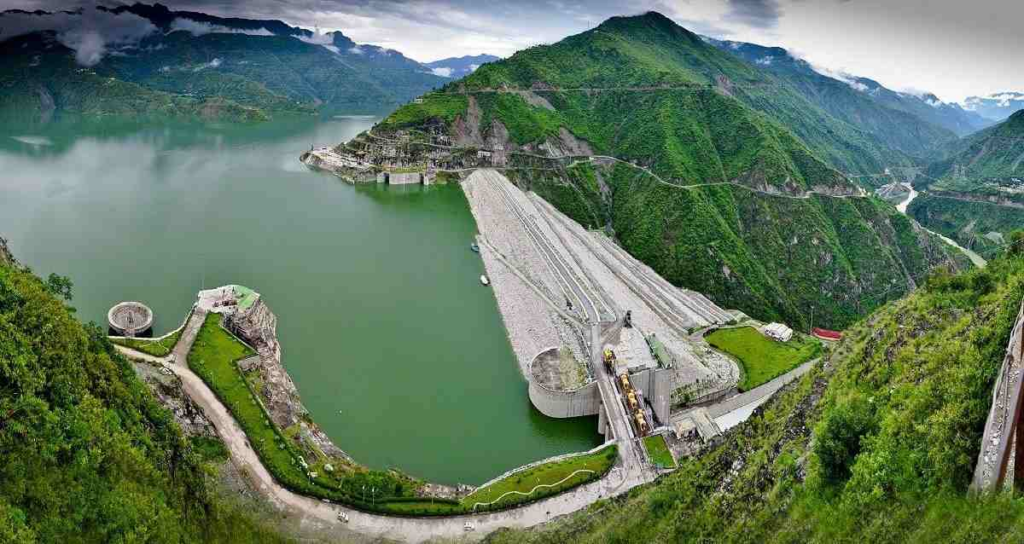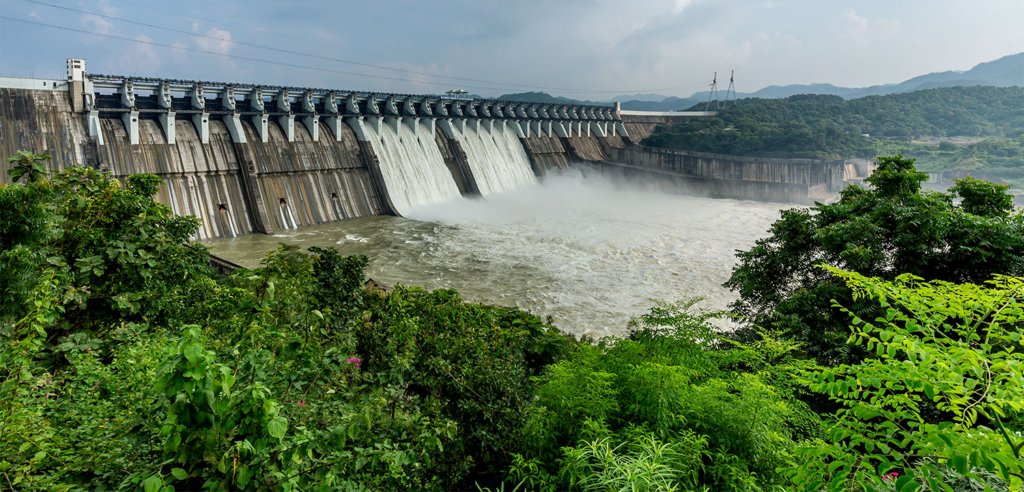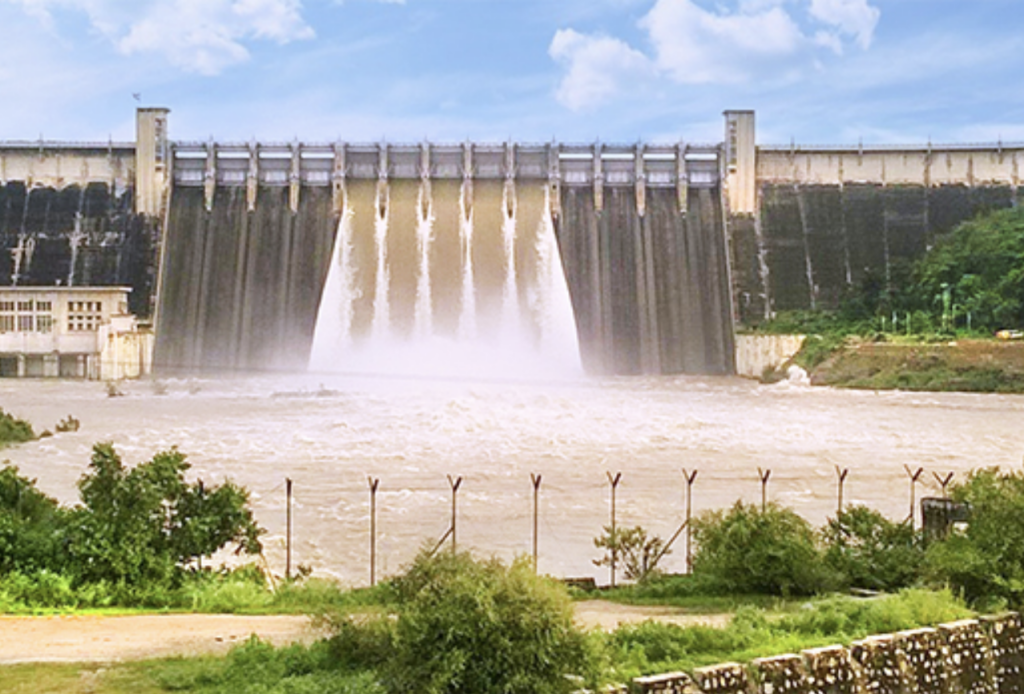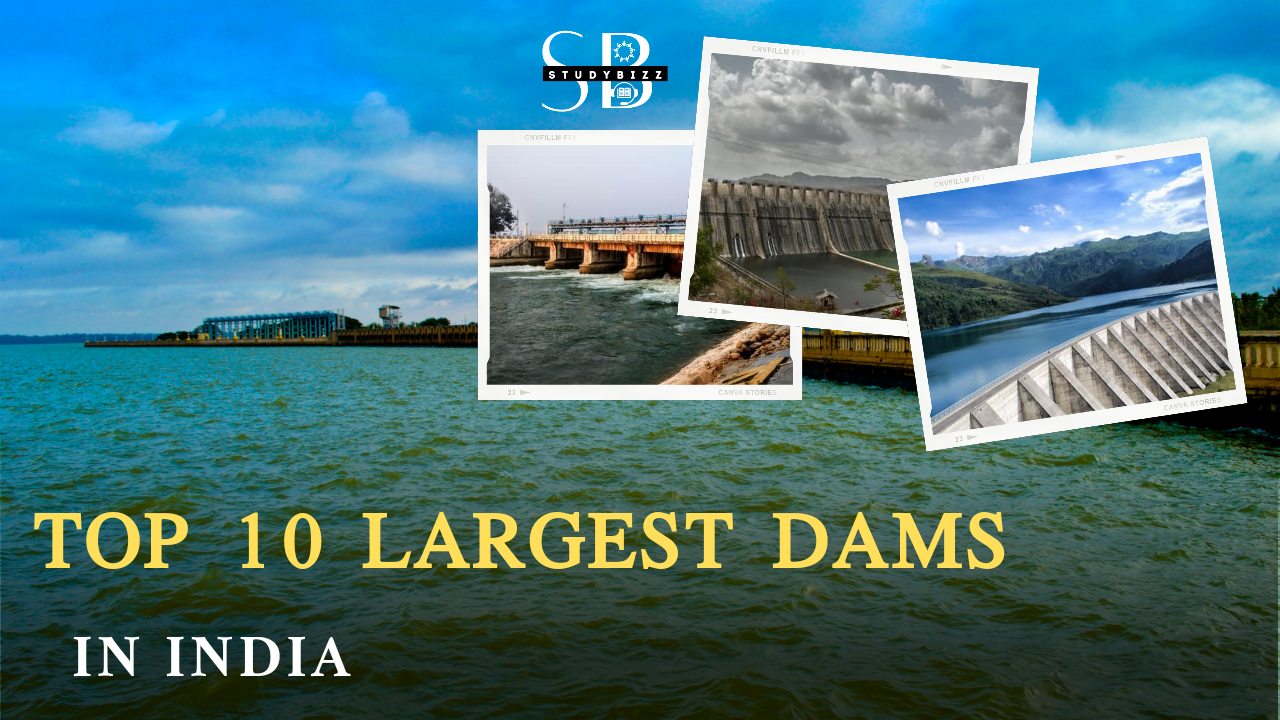Top 10 Largest Dams in India: India is a country full of diversity, culture and history. It is also the land of dams that play an important role in the country’s development and tourism. India is home to more than 4,300 dams, some of which are the largest, biggest, longest and tallest in the world.
In this article, we will introduce you to the 10 largest dams in India by different criteria, such as height, length, volume, and type.
1. Tehri Dam, Uttarakhand
Tehri Dam is the highest dam in India and one of the highest in the world. It is a multipurpose dam that serves as a source of hydroelectricity, irrigation, and drinking water. It is also a popular tourist destination that offers spectacular views of the Himalayas and the Bhagirathi River.

- Height: 260.5 m
- Length: 575 m
- River: Bhagirathi
- Location: Tehri, Uttarakhand
- Reservoir Capacity: 2.6 billion cubic metres
2. Bhakra Nangal Dam, Punjab
Bhakra Nangal Dam is the second-largest dam in India by reservoir capacity and one of the highest gravity dams in the world. It is a multipurpose dam that provides irrigation, power generation, and flood control. It is also a major attraction for tourists who want to witness the engineering marvel and the natural beauty of the region.

- Height: 226 m
- Length: 518 m
- River: Sutlej
- Location: Bilaspur, Himachal Pradesh and Nangal, Punjab
- Reservoir Capacity: 7.8 billion cubic metres
3. Idukki Dam, Kerala
Idukki Arch Dam is the tallest dam in India and one of the tallest in Asia. It is a double-curvature arch dam that generates hydroelectric power. It is also a major attraction for tourists who want to experience the scenic beauty and the biodiversity of the Western Ghats.

- Height: 168.91 m
- Length: 365.85 m
- River: Periyar
- Location: Idukki, Kerala
- Reservoir Capacity: 1.75 billion cubic metres
4. Srisailam Dam, Andhra Pradesh
The Srisailam Dam is constructed across the Krishna River on the border of Mahabubnagar District, Telangana and Kurnool District, Andhra Pradesh near Srisailam temple town and is the 2nd largest capacity working hydroelectric station in the country.
The dam was constructed in a deep gorge in the Nallamala Hills in between Mahabubnagar and Kurnool districts, 300 m (980 ft) above sea level. It is 512 m (1,680 ft) long, 145 metres (476 ft) maximum height and has 12 radial crest gates. It has a reservoir of 616 square kilometres (238 sq mi). The project has an estimated live capacity to hold 178.74 Tmcft at its full reservoir level of 885 feet (270 m) MSL. The left bank under-ground power station houses 6 x 150 megawatts (200,000 hp) reversible Francis-pump turbines for pumped-storage operation and the right bank semi-under-ground power station houses 7 x 110 megawatts (150,000 hp) Francis-turbine generators.

- Height: 145 m
- Length: 512 m
- River: Krishna
- Location:
- Reservoir Capacity: 8.722 km3
5. Sardar Sarovar Dam, Gujarat
Sardar Sarovar Dam is the largest dam in India by reservoir capacity and one of the largest in the world. It is a multipurpose dam that aims to provide water, power, and development to the states of Gujarat, Madhya Pradesh, Maharashtra, and Rajasthan. It is also a major attraction for tourists who want to see the Statue of Unity, the world’s tallest statue, located near the dam.

- Height: 138.68 m (455 ft)
- Length: 1,210 m (3,970 ft)
- River: Narmada
- Location: Kevadia, Gujarat
- Reservoir Capacity: 9.5 billion cubic metres
6. Nagarjuna Sagar Dam, AP & Telangana
Nagarjuna Sagar Dam is the third-largest dam in India by reservoir capacity and one of the largest masonry dams in the world. It is a multipurpose dam that provides irrigation, power, and drinking water. It is also a major attraction for tourists who want to explore the rich cultural and historical heritage of the region.

Height: 124.66 m (409 ft)
Length: 4,865 m
River: Krishna
Location: Palnadu district, Andhra Pradesh & Nalgonda district, Telangana
Reservoir Capacity: 11.56 billion cubic metres
7. Ukai Dam, Gujarat
The Ukai Dam, constructed across the Tapi River is the largest reservoir in Gujarat. It is also known as Vallabh Sagar. Constructed in 1972, the dam is meant for irrigation, power generation and flood control. Having a catchment area of about 62,255 sq. km and a water spread of about 52,000 hectares, its capacity is almost the same as that of the Bhakra Nangal Dam. The storage capacity of the Ukai dam is almost 46% of the total capacity of all the other existing dams in Gujarat if put together. Thus it can be concluded that the rest of the dams have as little as 0.1% average storage capacity. During the last 40 years, the actual irrigation potential has been attained through all the major and medium water resources projects in the State, which comprises only 14 million hectares.

Height: 105.16 m
Length: 4,927
River: Krishna
Location: Tapi District
Reservoir Capacity: 7.41 km3
8. Koyna Dam, Maharashtra
The Koyna Dam is one of the largest dams located in Maharashtra, India. It is a dam made of concrete and rubble built across the Koyna River, which originates in Mahabaleshwar, a hill town in the Sahyadri mountains. It is situated on the state route between Chiplun and Karad in Koyna Nagar, Satara district, in the Western Ghats. The Koyna Hydroelectric Project is India’s largest hydroelectric power plant, just after Tehri Dam Project. The Koyna dam provides hydroelectric power to nearby communities and water to Paschim, Maharashtra. Koyna Dam plays a significant role in preventing flooding during the monsoon season. By damming the Koyna River, the catchment area creates the 50 km long Shivsagar Lake. The hydroelectric capacity of Koyna Dam is 1,960 MW

Height: 103.2 m
Length: 807.2 m
River: Krishna
Location: Koyna Nagar, Maharashtra, India
Reservoir Capacity: 2.981 km3
9. Indira Dam, Maharashtra
Indira Sagar Dam is the fifth-largest dam in India by reservoir capacity and one of the largest hydroelectric projects in the country. It is a multipurpose dam that provides irrigation, power, and flood control. It is also a major attraction for tourists who want to enjoy the serene and tranquil environment of the dam and the reservoir.

Height: 92 m
Length: 653 m
River: Narmada
Location: Khandwa, Madhya Pradesh
Reservoir Capacity: 12.22 billion cubic metres
10. Rihand Dam, Uttar Pradesh
Govind Ballabh Pant Sagar Dam also known as Rihand dam is located near Pipri village in Sonbhadra district of Uttar Pradesh State, India. It is the largest multipurpose project in the state of Uttar Pradesh. This is the largest manmade reservoir/lake in India and also the largest dam in India by volume. It is on the river Rihand a main tributary of Son (Tributary of Ganga river). The catchment area of Rihand dam covers Uttar Pradesh, Madhya Pradesh & Chhattisgarh and it supplies irrigation water to Bihar state located downstream of the river. Lake is named after Bharat Ratna Pandit Govind Ballabh Pant, a freedom fighter who was also one of the modern architects.
The dam is a concrete straight gravity dam, It has a hydroelectricity power station of 300 MW capacities. Many superthermal power stations are located in the catchment area of the dam. These are Singrauli, Vindyachal, Rihand, Anpara & Sasan super thermal power stations and Renukoot thermal station. The power station is managed by U.P. Hydroelectricity Corporation Ltd. The water stored in Rihand Dam is released into River Son periodically for irrigation purposes throughout the year.

Height:91.44 m
Length: 934.45 m
River: Rihand
Location: Sonbhadra, Uttar Pradesh
Reservoir Capacity: 10.6 km3
Which is the highest dam in India?
The highest dam in India is Tehri Dam, which has a height of 260.5 m. It is located on the Bhagirathi River in Uttarakhand and serves as a source of hydroelectricity, irrigation, and drinking water. It is also a popular tourist destination that offers spectacular views of the Himalayas and the Bhagirathi River.
Which is the longest dam in India?
The longest dam in India is Hirakud Dam, which has a length of 25.8 km. It is located on the Mahanadi River in Odisha and provides irrigation, power, and flood control. It is also a major attraction for tourists who want to enjoy the panoramic views of the dam and the surrounding landscape.
Which is the largest dam in India?
The largest dam in India by reservoir capacity is Sardar Sarovar Dam, which can store up to 9.5 billion cubic metres of water. It is located on the Narmada River in Gujarat and aims to provide water, power, and development to the states of Gujarat, Madhya Pradesh, Maharashtra, and Rajasthan. It is also a major attraction for tourists who want to see the Statue of Unity, the world’s tallest statue, located near the dam.
Which is the most scenic dam in India?
The most scenic dam in India is Idukki Arch Dam, which is the tallest dam in India and one of the tallest in Asia. It is a double curvature arch dam that generates hydroelectric power. It is located on the Periyar river in Kerala and offers stunning views of the Western Ghats and the reservoir. It is also a major attraction for tourists who want to experience the scenic beauty and the biodiversity of the region.





Leave a Reply